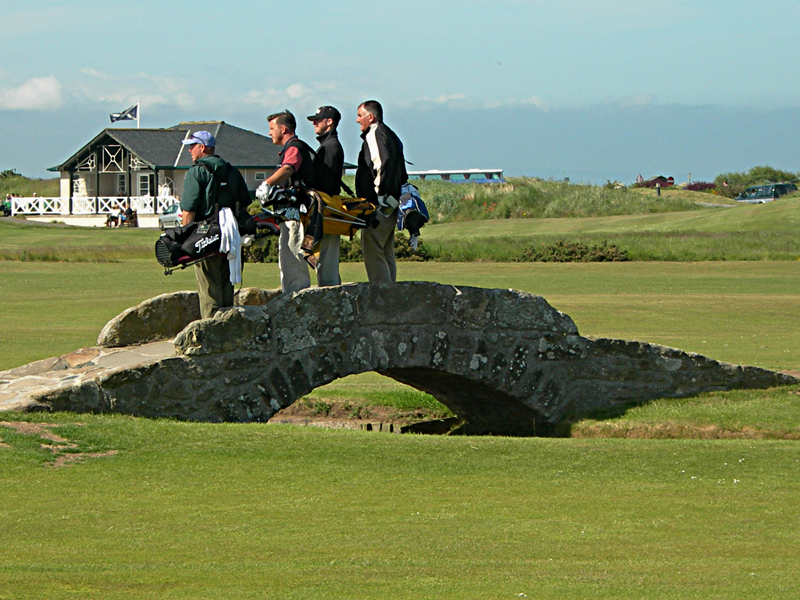
Golfers on the bridge - St Andrews Golf Links © 2006 Scotiana
.
Bonjour Marie-Agnès, Jean-Claude et Janice! Hello again, how are you? 🙂
.
Thank you for all your help in finding illustrations for our last Letter from Scotland (‘Daft Pate’ Macmillan of Courthill Smithy, Pioneer of the Pedal-Driven Bicycle).
.
We’re very pleased that “Kevin 76’s” (presumably a cycling enthusiast) should make available his excellent photographs from Keir Mill by posting them at flickr. It all helps to keep alive the name of the clever Dumfriesshire blacksmith!
.
The old print of Cycling (Le Cyclisme) that you found from 1887 – showing bikes with two wheels and with three – was quite charming. As a boy at school, beginning to study French, I was a little amused on first coming across such words as «le cyclisme» (cycling) or «le scoutisme» (scouting); to my young ears, these sounded strange, for in English the ending ‘-ism’ tends to be reserved for ideologies or movements (capitalism, communism) or even diseases (rheumatism)!
.
Our teachers had a habit of reminding us that our schooldays would be the happiest of our lives! (In fact, they were quite grim in many ways.) Marie-Agnès, we have loved especially the little stories you’ve told us from your own childhood – of hunting in the garden for Easter eggs, or learning to make apple pies as you stood at the elbow of a favourite aunt. I expect you had some neighbours too, of whom you were particularly fond? 🙂
.
Growing up in the suburbs of Glasgow, my sister and I were fortunate to have a close neighbour who was like a second grandmother to us; we thought of her as being very old and wise. Mrs Thomson seemed to know everything and to have an opinion on every subject! She would delight us by sometimes boiling up sugar in her small kitchen to make a sticky ‘caramel fudge’ (without any need of a recipe) – the sort of sweet to which some condensed milk is added.
Occasionally, our mother would confide in her, for ‘old’ Mrs Thomson had a clever strategy for offering advice. After tea – often served with home-made gingerbread, the pot always kept warm by a tea-cosy – she would ‘read’ the pattern of the leaves in my mother’s teacup! If she sensed that Mother had a worry or anxiety, gentle words of encouragement would be offered ..
.
.
And Mrs Thomson had sayings and aphorisms of her own. “Patience is not a virtue,” she’d say, “it’s a disease!” What, I wonder, would have been her opinion of golf (or, for that matter, of football, or even cricket) – all games for which enthusiasm has been known to amount to a passion?
.
No, golf is not a disease, although the phenomenon that is modern golf has spread through the world like a contagion, even to the roofs of skyscrapers and the decks of cruise liners, where the game is played in miniature. There are driving-ranges too; and for children and complete beginners ‘Family Golf Centres’, where the most basic instruction can be given, away from expensively-maintained courses.
.
Golf may not have been born in Scotland – the Dutch also claim it – but it evolved here over the centuries, under royal patronage, on the links courses of the East Coast. A few years ago, I asked Elinor Clark, Assistant Curator of the British Golf Museum at St Andrews, to tell me a little of the history of the game. “The earliest written reference to golf in Scotland is in the year 1457,” she said. “The parliament of the Scottish monarch, James II, tried to ban football and golf in favour of archery, which was considered more useful for national defence. But these games must have been extremely popular, for over 30 years later, parliament was still trying to stamp them out!”
.
Soon the King himself had taken up golf, playing with expensive clubs and the ‘feathery’ ball – a leather ball tightly stuffed with feathers. Most players could afford only wooden ones. King James IV bought a set of clubs from a bow-maker in Perth in 1503; James V also became an avid golfer, as did his daughter Mary (Queen of Scots) and his grandson, James VI. History relates that Mary was bitterly criticised by her enemies for playing golf at Seton Sands immediately after the murder of her husband, Lord Darnley, in 1567. James VI of Scotland, on becoming in 1603 King James I of Great Britain, took the game of golf south with him to London, where he played on Blackheath Common.
.
The origins of the modern Rules of Golf can be traced to 1744, when the Gentlemen Golfers of Leith (near Edinburgh) drew up the first list of 13. Ten years later (1754) the Society of St Andrews Golfers was founded by ‘twenty-two Noblemen and Gentlemen’. In 1834, by the patronage of King William IV, the Society was to become the illustrious Royal and Ancient Golf Club of St Andrews – the ‘R&A’ – now the governing body of British golf.
.
Golf’s popularity grew dramatically throughout Britain in late Victorian times, due to technical improvements as much as to changes in society. The ‘gutty’ ball (made of gutta-percha, a primitive rubber material) was introduced in 1848, and greatly improved the game; it was cheap, and could be hit much harder. Iron-headed clubs appeared too, with stronger American hickory-wood shafts. Thousands of new players took up the game, the number of clubs and societies increasing from under 100 in 1875 to about 1300 at the turn of the twentieth century! The invention, too, around this time of modern grass-cutting equipment allowed the full development of inland golf courses.
Scottish players had dominated golf since the earliest days; the greatest names were those of ‘Old’ Tom Morris and his son, ‘Young’ Tom. Old Tom came from St Andrews to the Prestwick Club (near Ayr) which in 1860 organised the first Open Championship; a contest which he was to win four times. The trophy then was a red leather belt with silver mountings.
After Young Tom in turn had won the championship for three years in succession (1868 -70) he was allowed to keep the red belt!
The new trophy was the famous one we know today – the tall silver claret jug (reminding us that the Scots did not always drink whisky!) Incredibly, Young Tom’s name was also the first to be engraved on the new jug following the championship of 1871, for he, too, had won a fourth Open!
.
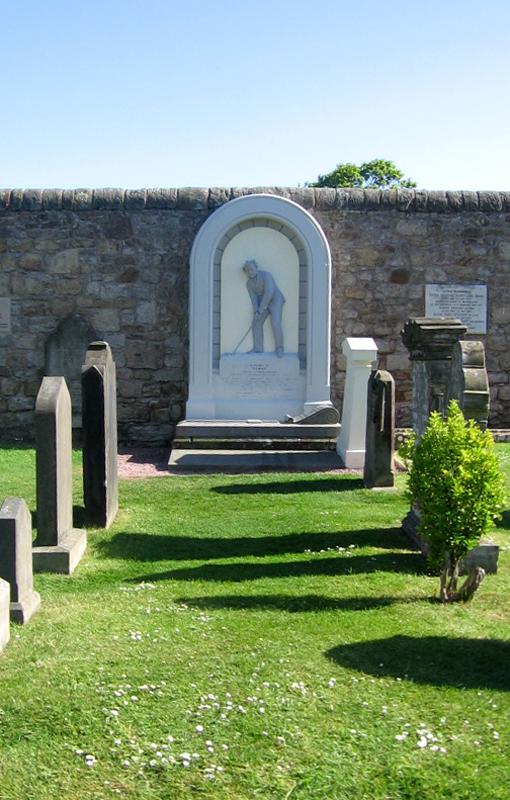
Scotland Five coast Young Tom Morris's grave in St Andrews chuchyard © 2006 Scotiana
And who knows how many more he might have won, had he not died tragically at the age of just 24? A phenomenal player! Scottish dominance ended in 1894, when an Englishman, J H Taylor, won the Open; but the Americans were soon to become world leaders in golf.
.
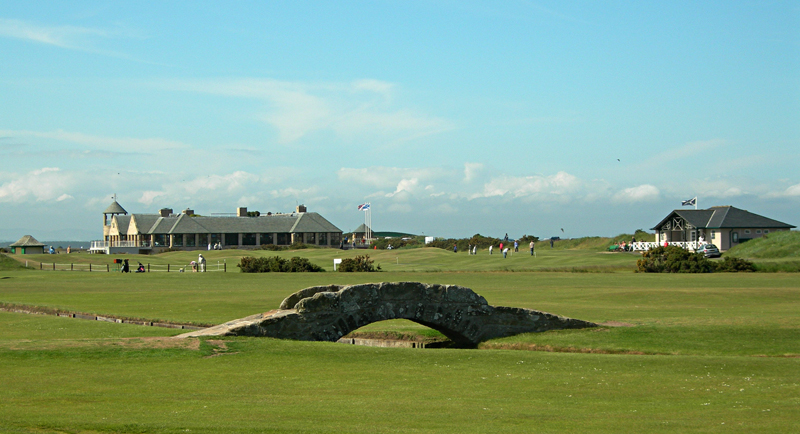
St Andrews Golf Links © 2006 Scotiana
Janice, Jean-Claude, Marie-Agnès, I really must say a word or two more about St Andrews, before ending this short account of the first days of golf in Scotland!
.
A very special atmosphere surrounds the Open Championship whenever it takes place on the Old Course by the sea at St Andrews, where golf has been played by rich and poor since 1400. This is, quite simply, the most famous course in the world; and, incredible as it may seem, it is possible for any competent golfer to play here, provided he wins a place in the daily ballot! (For details, enquire at the Tourist Information Centre.)
.
.
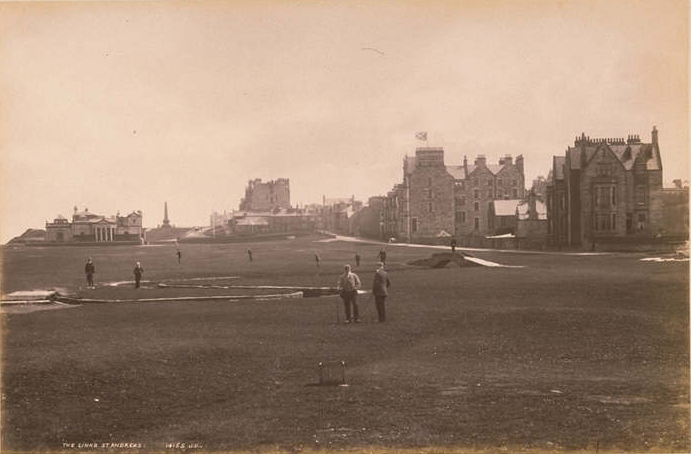
Old Course St. Andrews Scotland 1891 University of St. Andrews Library Photographic Archive J Valentine & Co, Wikipedia
“To walk on to the first tee of the Old Course, overlooked by the houses of the town, is to step nervously into the history of centuries,” wrote the Scottish golf historian, David Hamilton. What a thrilling experience for any golfer!
.
.
.
A bientôt,
.
Iain.
.
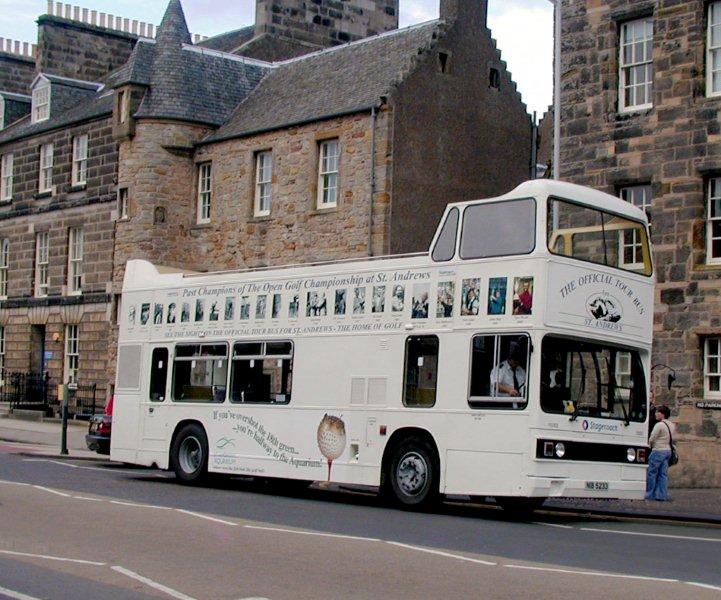
St Andrews The Official Tour Bus © 2003 Scotiana












wow!! I really enjoyed the content on this site. I loved your writing style, I have got some great ideas for my golf now. Keep up the good work Site owner! Cheers.
golf balls
Hello –
Thank you for your kind comments. We’re glad you enjoy our site.:-) In our Letters from Scotland, Margaret and I try to choose our words with care, conscious that what we write may remain available online for years to come; Mairiuna and Janice take the same care.
What a marvellous compliment to Scotland that they, along with Mairiuna’s husband, Jean-Claude, should have established Scotiana!
I’m sorry to be rather slow in leaving this reply for you – it’s been a busy summer – but on behalf of all the team, I’d like to send you our kindest regards. 🙂
Iain
Great great post!!!! I have seen this information as a blog. I like it and learned some French words here and it’s really funny. I like the story of you and about your neighbor grandmother, you are so lucky to have her. The history of golf is amazing and wonderful too. The behavior of writing a blog and relate it to another story is looking awesome.